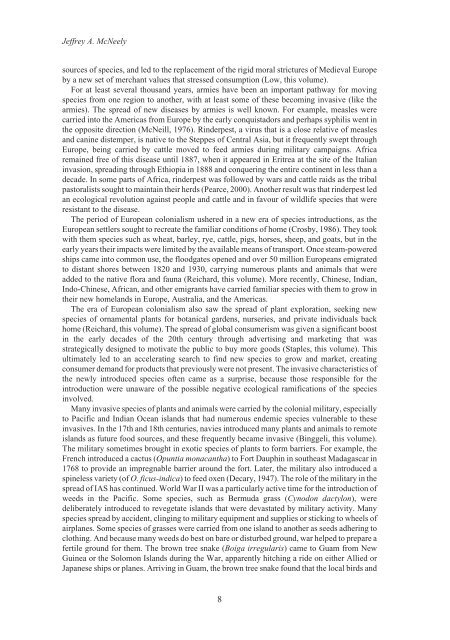Alien Species.vp - IUCN
Alien Species.vp - IUCN
Alien Species.vp - IUCN
Create successful ePaper yourself
Turn your PDF publications into a flip-book with our unique Google optimized e-Paper software.
Jeffrey A. McNeely<br />
sources of species, and led to the replacement of the rigid moral strictures of Medieval Europe<br />
by a new set of merchant values that stressed consumption (Low, this volume).<br />
For at least several thousand years, armies have been an important pathway for moving<br />
species from one region to another, with at least some of these becoming invasive (like the<br />
armies). The spread of new diseases by armies is well known. For example, measles were<br />
carried into the Americas from Europe by the early conquistadors and perhaps syphilis went in<br />
the opposite direction (McNeill, 1976). Rinderpest, a virus that is a close relative of measles<br />
and canine distemper, is native to the Steppes of Central Asia, but it frequently swept through<br />
Europe, being carried by cattle moved to feed armies during military campaigns. Africa<br />
remained free of this disease until 1887, when it appeared in Eritrea at the site of the Italian<br />
invasion, spreading through Ethiopia in 1888 and conquering the entire continent in less than a<br />
decade. In some parts of Africa, rinderpest was followed by wars and cattle raids as the tribal<br />
pastoralists sought to maintain their herds (Pearce, 2000). Another result was that rinderpest led<br />
an ecological revolution against people and cattle and in favour of wildlife species that were<br />
resistant to the disease.<br />
The period of European colonialism ushered in a new era of species introductions, as the<br />
European settlers sought to recreate the familiar conditions of home (Crosby, 1986). They took<br />
with them species such as wheat, barley, rye, cattle, pigs, horses, sheep, and goats, but in the<br />
early years their impacts were limited by the available means of transport. Once steam-powered<br />
ships came into common use, the floodgates opened and over 50 million Europeans emigrated<br />
to distant shores between 1820 and 1930, carrying numerous plants and animals that were<br />
added to the native flora and fauna (Reichard, this volume). More recently, Chinese, Indian,<br />
Indo-Chinese, African, and other emigrants have carried familiar species with them to grow in<br />
their new homelands in Europe, Australia, and the Americas.<br />
The era of European colonialism also saw the spread of plant exploration, seeking new<br />
species of ornamental plants for botanical gardens, nurseries, and private individuals back<br />
home (Reichard, this volume). The spread of global consumerism was given a significant boost<br />
in the early decades of the 20th century through advertising and marketing that was<br />
strategically designed to motivate the public to buy more goods (Staples, this volume). This<br />
ultimately led to an accelerating search to find new species to grow and market, creating<br />
consumer demand for products that previously were not present. The invasive characteristics of<br />
the newly introduced species often came as a surprise, because those responsible for the<br />
introduction were unaware of the possible negative ecological ramifications of the species<br />
involved.<br />
Many invasive species of plants and animals were carried by the colonial military, especially<br />
to Pacific and Indian Ocean islands that had numerous endemic species vulnerable to these<br />
invasives. In the 17th and 18th centuries, navies introduced many plants and animals to remote<br />
islands as future food sources, and these frequently became invasive (Binggeli, this volume).<br />
The military sometimes brought in exotic species of plants to form barriers. For example, the<br />
French introduced a cactus (Opuntia monacantha) to Fort Dauphin in southeast Madagascar in<br />
1768 to provide an impregnable barrier around the fort. Later, the military also introduced a<br />
spineless variety (of O. ficus-indica) to feed oxen (Decary, 1947). The role of the military in the<br />
spread of IAS has continued. World War II was a particularly active time for the introduction of<br />
weeds in the Pacific. Some species, such as Bermuda grass (Cynodon dactylon), were<br />
deliberately introduced to revegetate islands that were devastated by military activity. Many<br />
species spread by accident, clinging to military equipment and supplies or sticking to wheels of<br />
airplanes. Some species of grasses were carried from one island to another as seeds adhering to<br />
clothing. And because many weeds do best on bare or disturbed ground, war helped to prepare a<br />
fertile ground for them. The brown tree snake (Boiga irregularis) came to Guam from New<br />
Guinea or the Solomon Islands during the War, apparently hitching a ride on either Allied or<br />
Japanese ships or planes. Arriving in Guam, the brown tree snake found that the local birds and<br />
8












